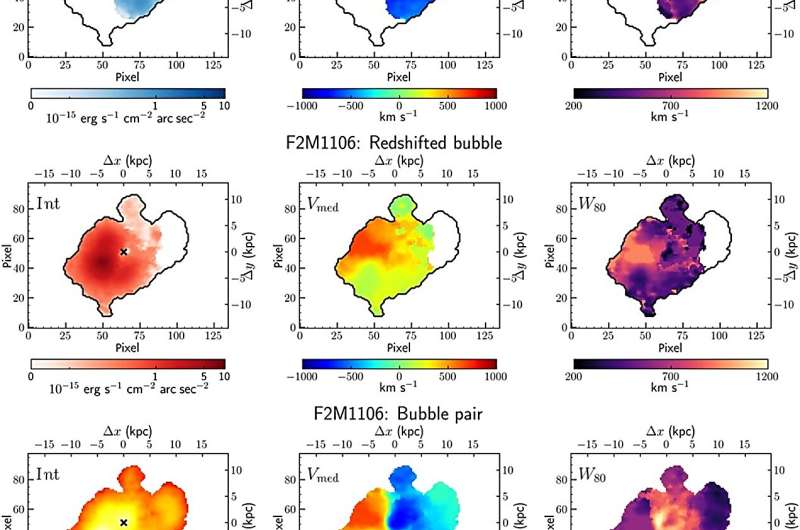July 14, 2023 report
This article has been reviewed according to Science X's editorial process and policies. Editors have highlighted the following attributes while ensuring the content's credibility:
fact-checked
peer-reviewed publication
trusted source
proofread
Astrophysicists discover spectacular quasar-driven superbubbles in three luminous red quasars
![The results of our 2D hydrodynamics simulation well reproduced the morphology and kinematics of the observed superbubbles.(A) The [O III] emission coefficient map, (B) the [O III] surface brightness map, (C) the median velocity map, (D) the W80 map, and (E) the [O III] emission line profiles at the location marked as white lines in the W80 map (D). Credit: Science Advances (2023). DOI: 10.1126/sciadv.adg8287 Ionized gas nebulae surrounding three luminous red quasars discovered featuring pairs of 'superbubbles'](https://scx1.b-cdn.net/csz/news/800a/2023/ionized-gas-nebulae-su.jpg)
A team of astrophysicists with members from China, the U.S. and Germany has discovered ionized gas nebulae surrounding three luminous red quasars featuring pairs of "superbubbles." In their study, reported in the journal Science Advances, the team spotted and analyzed the superbubbles using data from the Gemini North telescope in Hawaii.
Prior research has suggested that quasars could be involved in the formation of galaxies—the bright, supermassive black holes are known to generate galactic winds with outflows measuring tens of parsecs. But the dynamics of such quasars has mostly remained a mystery. In this new effort, the researchers looked at red quasars, which have well-known strong luminescence, to learn more about how the wind they generate might influence galaxies that form around them.
The researchers studied data from the Gemini North 8m Telescope in Hawaii. They discovered a nebula that they describe as peanut-shaped. It had pairs of bubbles that emanated blueshift (high frequency) and redshift (low frequency) light. A closer look using integral field unit spectrograph technology showed that the peanut formation surrounded three quasars.

The research team then created 2D hydrodynamic simulations over a 20-million-year timescale to study these nebulae as they were impacted by their associated quasar winds. They found that the winds were caught for a time in the superbubble but then moved on to a break-out phase. The researchers found that such superbubbles resembled the Fermi bubbles in the Milky Way.
The observations and simulations suggest that quasar-generated winds do indeed play a role in galaxy formation. They also suggest that the bubble structures play a role in the phase of galaxy formation in which nebulae are blown from their host galaxies into a surrounding galactic halo.
More information: Lu Shen et al, Discovery of spectacular quasar-driven superbubbles in red quasars, Science Advances (2023). DOI: 10.1126/sciadv.adg8287
Journal information: Science Advances
© 2023 Science X Network





















